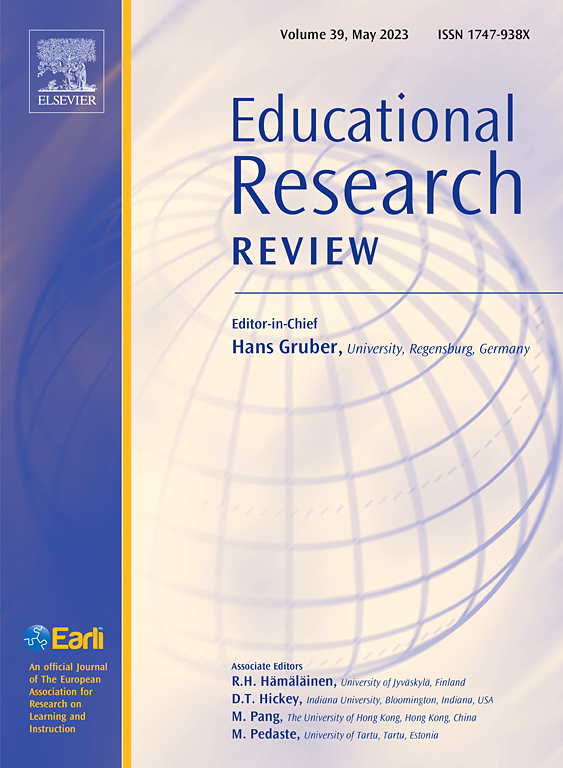多媒体条件下母语和图片对二语词汇学习效果的meta分析
IF 10.6
1区 教育学
Q1 EDUCATION & EDUCATIONAL RESEARCH
引用次数: 0
摘要
多媒体输入经常用于第二语言词汇学习;然而,多媒体输入对二语词汇学习的有效因素尚未确定。本研究旨在识别多媒体二语词汇学习中的有效因素,并进一步阐明不同“域”在多媒体二语词汇学习中的意义。考虑到学习目标(二语词汇)属于语言域,将有意义的输入构建为域内(即基于L1)、跨域(即基于图片)和混合域(即基于L1+图片)的学习条件。本研究首先进行了综合分析,然后进行了三项荟萃分析:(a)域内vs跨域(20项研究,51个效应量),(b)域内vs混合域(21项研究,55个效应量),(c)跨域vs混合域(9项研究,27个效应量),共2056名参与者。即时测试和可用延迟测试均作为因变量。四个调节因子被用来识别潜在的预测因子。结果表明,在即时测试中,混合域条件始终优于域内条件(g = 0.334, p <;跨域条件(g = 0.350, p = 0.001)对二语词汇学习的促进作用。然而,在延迟测试中,混合域条件的有利效果仅略优于跨域条件(g = 0.271, p = 0.067)。二语词汇学习的域内条件和跨域条件无显著差异。在立即测试或延迟测试中均未检测到重要的减缓剂。这些发现强调了将母语词汇和图片结合到第二语言词汇学习中的好处。本文章由计算机程序翻译,如有差异,请以英文原文为准。
Effectiveness of L1 and pictures in multimedia conditions on learning second-language vocabulary: A meta-analysis
Multimedia inputs have been often used in second language (L2) vocabulary learning; however, the effective elements in multimedia inputs for L2 vocabulary learning have hardly been established. This study aims to identify the effective element(s) and further clarifies the meaning of different “domains” in multimedia L2 vocabulary learning. Considering that the learning target (L2 vocabulary) belongs to the verbal domain, the meaningful inputs are then constructed as within-domain (i.e. L1-based), cross-domain (i.e. Picture-based), and mixed-domain (i.e. L1+picture-based) learning conditions. The present study firstly conducted an omnibus analysis and then three meta-analyses: (a) within-domain vs. cross-domain (20 studies, 51 effect sizes), (b) within-domain vs. mixed-domain (21 studies, 55 effect sizes), and (c) cross-domain vs. mixed-domain (9 studies, 27 effect sizes), for a total of 2056 participants. Both immediate and available delayed tests were used as dependent variables. Four moderators were used to identify potential predictors. The results indicate that, at the immediate tests, the mixed-domain condition consistently outperforms the within-domain condition (g = 0.334, p < 0.001) and cross-domain condition (g = 0.350, p = 0.001) in facilitating L2 vocabulary learning. However, at the delayed tests, the advantageous effect of the mixed-domain condition only marginally outperformed the cross-domain condition (g = 0.271, p = 0.067). No significant difference was found between the within-domain and cross-domain conditions in L2 vocabulary learning. No significant moderator was detected at either the immediate tests or the delayed tests. These findings highlight the benefit of incorporating both L1 words and pictures into L2 vocabulary learning.
求助全文
通过发布文献求助,成功后即可免费获取论文全文。
去求助
来源期刊

Educational Research Review
EDUCATION & EDUCATIONAL RESEARCH-
CiteScore
19.40
自引率
0.90%
发文量
53
审稿时长
57 days
期刊介绍:
Educational Research Review is an international journal catering to researchers and diverse agencies keen on reviewing studies and theoretical papers in education at any level. The journal welcomes high-quality articles that address educational research problems through a review approach, encompassing thematic or methodological reviews and meta-analyses. With an inclusive scope, the journal does not limit itself to any specific age range and invites articles across various settings where learning and education take place, such as schools, corporate training, and both formal and informal educational environments.
 求助内容:
求助内容: 应助结果提醒方式:
应助结果提醒方式:


